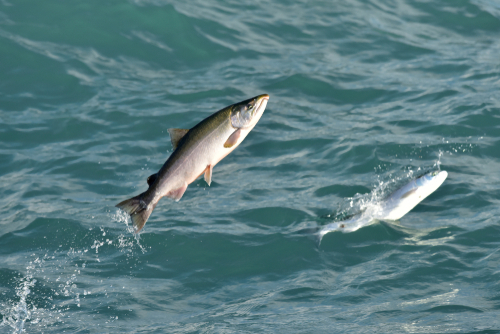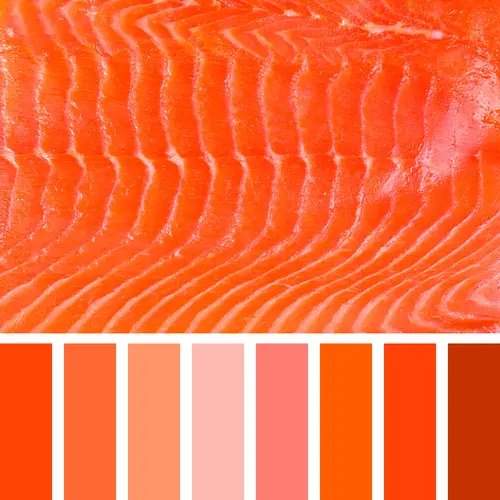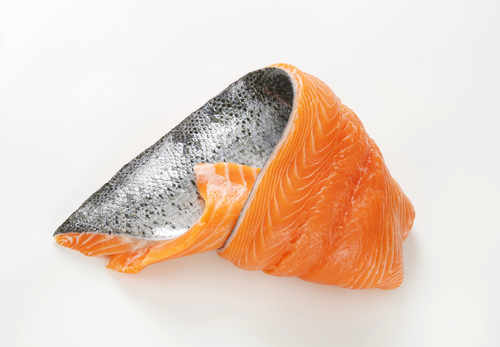When buying salmon, most people consider the color first. Salmon at any store is usually pink, and a healthy hue is the first thing that attracts buyers.
There’s even a “salmon” color that is used to describe the specific shade of pink that adorns the juicy fillets sold at fish markets.
However, salmon is not naturally pink. It is gray in its natural state. The pink hue is a result of astaxanthin, a substance found in krill and shrimp, which are a common source of food for salmon. Astaxanthin contains the coloring that turns naturally gray salmon into the popular pink shade.
If salmon is naturally gray, how do wild salmon differ in color from farm-raised salmon, and does the color affect the nutrition content of the fish? We answer these questions and more in our quick read below.
What Color Is Salmon Naturally?
Most people have only seen pink salmon. Restaurants, fish markets, and even pictures online usually show salmon as a pink fish. The only difference in salmon color is the intensity of the shade of pink the salmon has.
However, salmon is gray in color. In the wild, salmon feeds on a wide variety of prey, including krill and shrimp. Krill and shrimp contain astaxanthin, which is responsible for the pink color in salmon.
That’s why naturally occurring salmon come in different hues of pink or orange. Some are intense, while others can be pale pink.
Additionally, the concentration of astaxanthin is another way that sellers market salmon. Salmon with high astaxanthin levels include the Wild Alaskan sockeye salmon.
Why Is Farm-Raised Salmon gray?

Farm-raised salmon do not have access to naturally occurring sources of astaxanthin, such as krill and shrimp. Salmon raised in controlled environments eat what the farmers provide.
The diet in salmon farms mostly consists of fish feed and oil from smaller fish. None of these contain the astaxanthin that turns naturally gray salmon into pink or orange.
Why Are They Dyed Pink Or Red?
Salmon farmers feed their fish naturally occurring or lab-grown astaxanthin to turn them pink. The astaxanthin is neither pink nor red.
The farmers determine the intensity of the color of their salmon by regulating how much astaxanthin they feed the fish.
Some astaxanthin sellers even offer a controlled color palette to salmon farmers. This color range helps farmers determine how pink, red, or orange their salmon will turn out to be.
The process of turning gray salmon into shades of pink can be quite expensive. It contributes to almost 20% of production costs in salmon farms.
However, almost all salmon consumers prefer their fish pink, making this process a do-or-die for the farmers. However, the costs are more or less covered by high profit margins from the sale of salmon.
What Color Is Wild Salmon?

Wild salmon is pink in color, with varying intensities. In its natural habitat, salmon has access to a rich diet of foods high in astaxanthin. Wild salmon, therefore, turns pink without the need for dye.
Astaxanthin concentrates are available at different levels, even in wild waters. The amount of astaxanthin available naturally will determine how light or dark the shade of salmon will be.
Deep-shade salmon, such as the Wild Alaskan sockeye salmon, have the highest concentration of astaxanthin globally.
The astaxanthin found in wild salmon is a beneficial antioxidant for the human body. It helps protect cells from damage, promotes heart health and healthy skin, and even slows down the effect of Alzheimer’s’ disease.
Different wild salmons have different levels of astaxanthin. The sockeye salmon has the highest concentration of astaxanthin with 6.78m. King salmon has the lowest concentration with 1.49mg astaxanthin per 6 oz.
The DSM Salmon Color Fan Explained

Salmon comes in all shades of pink, orange, and even red. Considering the numerous salmon farmers and wild-caught salmon varieties worldwide, a globally acceptable color scheme system to identify the fish by gradient is necessary.
Color systems for salmon shades help farmers, buyers, and sellers, globally to label their fish in a universally acceptable language.
There are three major color scheme systems for grading salmon by their shades; multi-spectral imaging, CIELAB point measure, and SalmoFan™ by DMS.
To uniformly identify and label the different shades of salmon out there, an innovative company came up with the SalmoFan™. The SalmoFan™ is a fan-shaped tool used to measure the shade of salmon fillets.
There are 15 strips on the SalmoFan™ numbered from 20 to 34, with 20 being the lowest, lightest shade of salmon there is. High scores on the SalmoFan™ usually mean a richer quality salmon and a higher price.
Is The Color Added To Salmon Harmful?
Farmed salmon usually comes with “color added” on the label. This tag refers to the artificial astaxanthin added to the fish diet to turn its color from gray to different shades of pink.
Is this color safe to eat? Yes, artificial astaxanthin is safe for human consumption. According to the U.S. Food and Drug Administration, artificial astaxanthin is safe in farmed salmon as long as it stays within 80 milligrams of every kilogram added.
Salmon experts reiterate that omitting the artificial color could be detrimental to the health of both salmon and people who buy any gray salmon.
Since astaxanthin is a strong antioxidant, it is a necessary nutrient for the body. Astaxanthin fights inflammation, thus lowering the effects of diseases such as rheumatoid arthritis, diabetes, and heart conditions.
Read Also: Haddock vs Cod Fillets: The Main Differences Explained
Is Pink Salmon As Healthy As Gray Salmon?
The pink color in salmon is present because of astaxanthin. Gray salmon does not contain astaxanthin.
Astaxanthin is a powerful antioxidant that has been proven to offer numerous health benefits. These include;
- Healthy skin aging.
- Promote cardiovascular health.
- Promote eye health.
- Reduce growth of breast cancer cells.
Pink salmon is much healthier than gray salmon. Additionally, when using the SalmoFan™, the deeper the shade of pink, the higher the concentration of astaxanthin, and the healthier the salmon.


